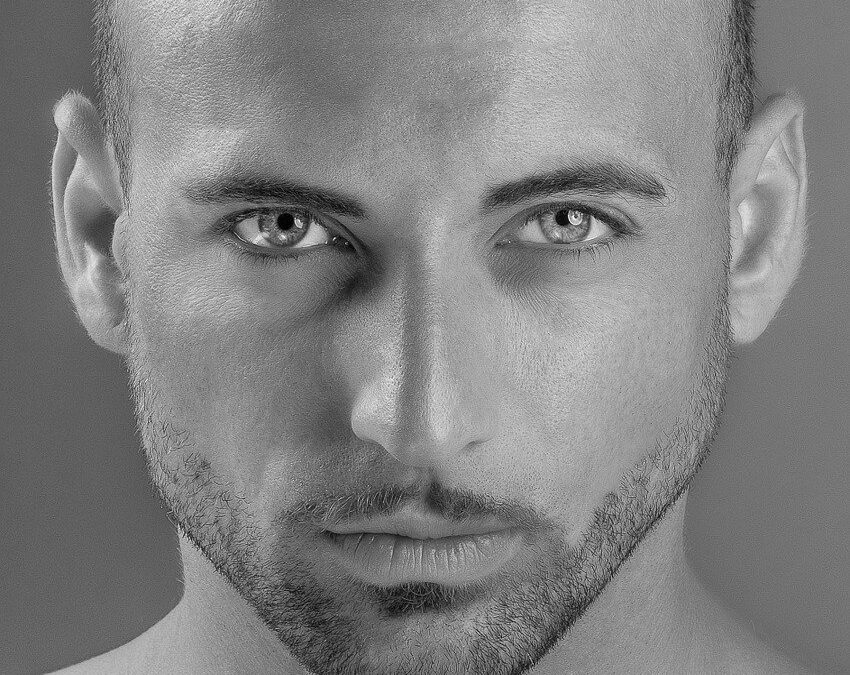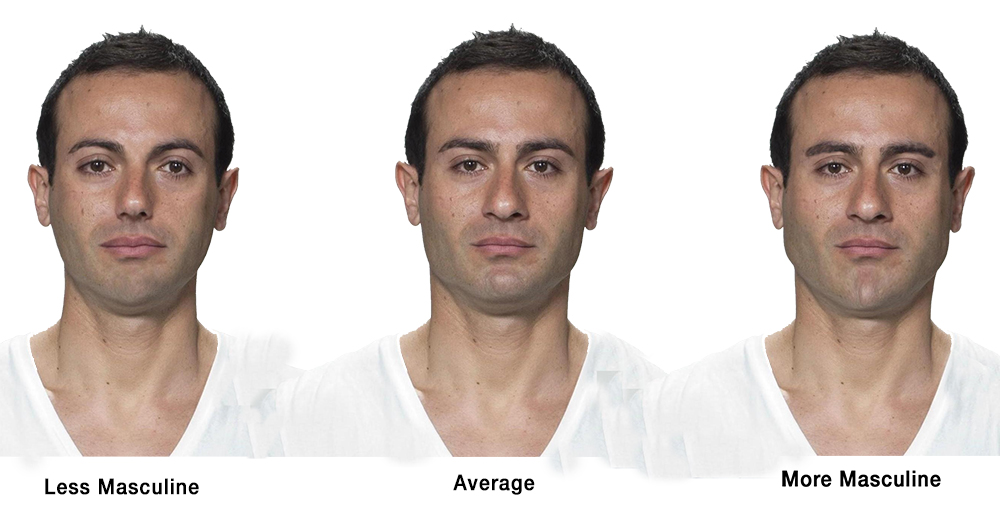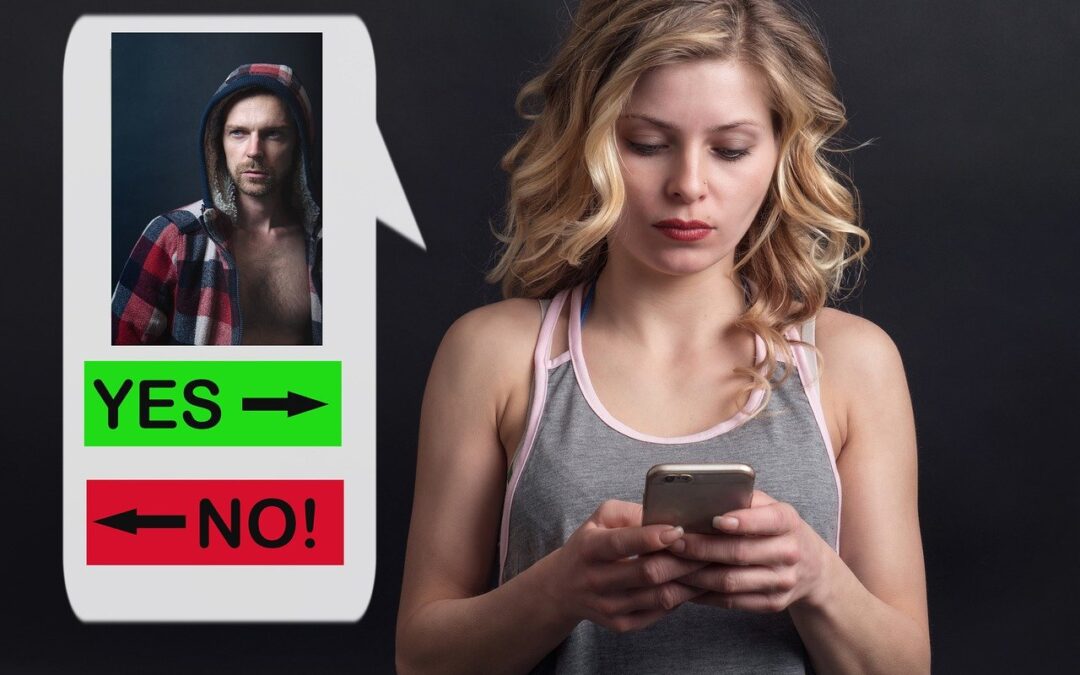
Women’s Preferences for Male Facial Masculinity
“The face is more honest than the mouth will ever be.”
~ Daphne Orebaugh
In a prior post (Want An equal Marriage? Then Date As Equals), I described the “trade-off problem” (coined by evolutionary psychologists) that women have in choosing between male alpha traits of dominance and status and male beta traits of loyalty and kindness. Recent research reveals this trade-off phenomenon is operative when a woman rates a man’s attractiveness as a function of his facial masculinity. Do women who are attracted to men prefer a macho, masculine appearance? Or is a gentler, more feminine face the ideal?
Take-away – High-level
Along a continuum of digitally produced hyper-feminine to hyper-masculine faces, women preferred the “moderately” masculine face. Women’s preference for moderately masculine faces comports directly with the overall female mating strategy that attempts to find the “sweet spot” of an alpha-dominant man (with resources, prestige, and hierarchical power) and a “beta” man who will be trustworthy and invest in her children. This trade-off problem is solved by finding a compromise for facial masculinity – identifying a masculine face rated above the mean but not so masculine as to be perceived as untrustworthy. A preference for “moderately” masculine faces demonstrates the combination of a woman’s long-term and short mating strategy and her competing intentions for selecting traits in an ideal mate.
Order of Facial Preference (Summary)
After moderately masculine faces, the order of preference for male faces was “intermediate” (balanced masculine and feminine) faces, followed by extremely masculine and moderately feminine faces. Extremely feminine (male) faces were the least attractive to heterosexual women.
Masculine Traits in the Animal Kingdom
In the rest of the animal kingdom, males with exaggerated masculine traits are favored. For example, the showy plumage of a bird of paradise or the puffed-up chest of a silver-back gorilla makes these animals luckier in love. This is likely because there is a link between these macho traits and health and vigor. A preference for masculine traits is a preference for a male who will make a good biological father.
Tough Guys and Sensitive Types
In our species, perhaps unsurprisingly, the story is more complicated. Some women prefer “tough guys,” and others prefer more sensitive types. Why? In some circumstances, masculine qualities are more valuable. In others, a more feminine partner might be the better choice.
Dimorphism and the Masculine Human Face
Men’s facial masculinity expresses the degree of dimorphism or physical differences between the sexes in humans. A masculine face has narrower eyes and thinner lips; a broader mandible (jawbone), chin, forehead, and (wider) nose; larger cheekbones, a long lower face height below the nasal region, a more protruded and robust brow ridge, straighter eyebrows, facial hair, and darker complexion. The heavy lower face that women favor in men is a visible record of the surge in testosterone and other male sex hormones that turn small boys into athletic men.
Male Facial Hair and Attractiveness
A paper published in January 2020 found that facial masculinity was positively correlated with attractiveness, and beards significantly increased attractiveness in both short-term and long-term scenarios. The effect is demonstrated by the fact that full-bearded feminine (male) faces (otherwise least attractive) were rated as more attractive than clean-shaven moderately masculine faces (otherwise, the most attractive).
“Moderate” Man Pictured Above
The signature image for this post demonstrates (IMO) a moderately masculine face. This man has narrow eyes, a wide jaw bone, prominent cheekbones, a fairly robust brow ridge, facial hair, and a darker complexion. He does not have a broad nose or significant face height below the nasal region. His facial symmetry (see Appendix) is nearly perfect, generating overall attractiveness (and perhaps a touch of femininity). His expression is determined, if not slightly menacing, adding an artifact to his overall masculinity.
What is a Feminine Face?
Given the dimorphism between the sexes, it is necessary and instructive to consider the “feminine face” to access levels of facial masculinity. Social psychologist Michael Cunningham at the University of Louisville found dimensions and proportions of the ideal female face: large eyes, small chin and nose, high cheekbones, and narrow cheeks. These traits are signs that a woman has reached puberty. The tiny jaw is essentially a monument to estrogen and obliquely to fertility – signaling the increased odds that she could get pregnant. High eyebrows, dilated pupils, and broad smile signal excitement and sociability. Cunningham also found that men are looking for lips that have “fullness, redness, and warmth.”
Hyperfeminine Face
When researcher David Perrett exaggerated the ways in which the prettiest female composite differed from the average composite, the resulting face was judged more attractive. “It turned out that the way an attractive female face differs from an average one is related to femininity,” say Perrett. “For example, the female eyebrows are more arched than males and exaggerating the difference from average increases femininity.” Perrett created a “hyperfeminine” face in his studies by slightly changing the face to have larger eyes, a smaller nose, plumper lips, a narrow jaw, and a smaller chin. (See “Averageness and Exceptionality” in Appendix.)
The hyperfeminine face is considered attractive (if not beautiful) by both men and women. The hypermasculine face is considered less attractive than average, especially by women.
Healthy Men Can Afford High Levels of Testosterone
Facial masculinity is a secondary sexual trait caused by sex-specific ratios of androgens (testosterone) and estrogens, affecting morphology (physical form and structure) and behavior. It is hypothesized that women should find facial masculinity attractive in potential mates because masculinity may act as an honest signal for male health. Only men with above-average health in adolescence can “afford” to produce high levels of testosterone that masculinizes the face. Facial masculinity is positively associated with some aspects of men’s health and disease resistance.
Facial Masculinity May Signal Competitive Ability
Facial masculinity may signal competitive ability to other men and the ability to provide protection and resources. It may also provide relevant information to potential mates and same-sex rivals regarding reproductive maturity, underlying health, formidability, and social status. More masculine-looking men tend to have more muscular physiques and greater physical strength, health, and competitive ability.
Facial Masculinity is Associated with Behavioral Dominance
Facial masculinity is associated with behavioral dominance, an open sociosexual orientation (level of “sapiosexuality”*), and higher social rank in same-sex dominance hierarchies. It has been reported that square-jawed men start having sex earlier than their peers and attain higher ranks in the military.
Trade-off: Good Health vs. Good Parent
Masculine facial traits increase both perceived dominance and decreased quality as a parent. High levels of testosterone have been linked to undesirable social traits such as aggression and decreased parental investment. Again, women may face a trade-off between choosing a less masculine but more agreeable (and investing) long-term partner versus choosing a man whose masculine appearance indicates good health — but who may have less socially desirable traits. Thus, variation in preference for masculine men may reflect choices for more prosocial partners and nurturing fathers over possible indirect (genetic) and direct benefits associated with masculine facial traits.
“Masculine” Men and Likelihood of Sexual Infidelity
Masculine-looking men are perceived to be less warm, kind, and less paternally investing. Further, masculine men state higher preferences for short-term mating than for long-term relationships. They engage in more short-term relationships than their less masculine peers, and women accurately assign the likelihood of sexual infidelity for the masculine facial shape in static photographs. Women find less masculine faces more attractive for a long-term relationship, perhaps because macho men are generally less committed.
Women Prefer More Masculine Men for Short-term Flings
Illustrating collusion or synergy related to a masculine man’s short-term mating preference, the results of 15 years of research consistently show that women find above-average masculine faces to be sexiest and most attractive for a casual sexual encounter.
Study Rated Degrees of Facial Masculinity
As reported in Adaptive Human Behavior and Physiology (2017), Iris Holzleitner (Institute of Neuroscience & Psychology in Glasgow) published a comprehensive study of how women differ in their preferences for male facial masculinity. Holzleitner recruited 563 women who rated the attractiveness of a set of male faces that had been manipulated to appear more feminine or more masculine. Masculine faces were altered to have a more robust jaw, narrower eyes and lips, and a wider nose. In many research studies, volunteers are only asked to compare one feminized face with one masculinized face; in Holzleitner’s study, volunteers individually rated faces of varying degrees of masculinity.
Example of Continuum of Facial Masculinity
Degrees of facial masculinity are depicted below as an illustrative example. The “average” face is from a research data set; the “less masculine” and “more masculine” faces are alterations from the “average” made by web-master and photographer Tom Carroll, especially for this post. Changes to the jawline, cheeks, chin, lips, eyes, and eyebrows exaggerate the difference between a “feminized” male face and a strong (perhaps “hyper”) masculine face; Holzleitner’s computer-generated facial changes were more subtle, systemized, and “mathematical” along a continuum. The average face depicted here is roughly equivalent to a “moderately” masculine face.

Women Preferred the “Moderately Masculine”
Holzleitner found that women most preferred male faces that were moderately masculine. Very masculine or feminine faces were less appealing. However, the degree of masculinity a woman preferred in a man’s face depended somewhat on her own characteristics.
Sexual Orientation-Fluidity Effect
Not surprisingly, women who had some attraction to women tended to rate feminine male faces more attractive. Whereas women who were exclusively attracted to men had a stronger preference for more masculine faces. “The more women were exclusively sexually attracted to men, the more attractive they found highly masculine faces,” reported Holzleitner.
Recent Research on Sexual Fluidity Effect
Variations in the sexual orientation (degree of fluidity or “hetero-flexibility”) of self-identified heterosexual women influence preferences for male facial masculinity, according to recent research by Carlotta Batres (2020) published in the International Journal of Sexual Health. Batres is a professor and director of The Preferences Lab** at Franklin & Marshall College.
Batres and colleagues asked 27,611 heterosexual women to report their level of sexual attraction to women, level of sexual attraction to men, hormonal contraceptive use, relationship status, attitude toward casual sex, and self-assessed attractiveness. The participants were then shown pairs of male faces and instructed to select which face from each pair they considered to be the most attractive.
Sixty-two Percent of Heterosexual Women Reported Some Attraction to Women!
Even though all the women identified as heterosexual, 62.6% reported some level of sexual attraction to other women. This finding was quite significant (if not surprising) by itself. But more pertinent to the study was the finding that attraction to women influenced assessments of male attractiveness.
“Heterosexual” Women Who Are Attracted to Women Prefer Less Masculine Faces
Batres found the same effect as did Holzleitner. Women with higher levels of attraction to other women were more likely to view less masculine-looking male faces as more attractive.
Attractive Women Did Not Prefer Feminine Faces
Women also differed in their preferences according to their self-rated attractiveness. Women who thought they were high in attractiveness didn’t find feminine male faces very attractive at all, but less attractive women rated them moderately appealing. Both self-rated attractive and self-rated unattractive women agreed that moderately masculine men were the most appealing and that very masculine men were slightly less so (as in “order of preference above”).
More Attractive Women Want More Masculine Faces
Stated another way, more attractive women showed less tolerance for lower levels of masculinity than did less attractive women. The more physically attractive the woman (by self-rating), the stronger preference for higher levels of masculinity. More attractive women also showed greater discrimination than less attractive women in their preference for masculine faces.
Male-Female Polarity Phenomenon
Greater discrimination or more “choosiness” is a predictable behavior of more attractive women. As uncovered in Batres’ research, this result is a phenomenon of male-female polarity: beautiful women want and get more masculine men (men with masculine facial features, taller, and with more defined v-shaped torsos). This polarity seems biologically unconscious as well as predicted by “sorting” in the mating economy. There is a “mate value” agreement: beautiful women have a high mate value and taller, masculine men generally have higher mate value than shorter and less physically masculine men.
Beautiful Women Can “Afford” More Masculine Men
Attractive women have more immunity from the costs of disloyalty often imposed by more masculine men. Masculine men are less likely to abandon very beautiful women. The costs are higher for less attractive women – those women calculate the risk and often “trade” for more “beta” character traits in their choice of a long-term partner.
Women Prefer Masculine Faces in Better Economic Conditions
According to a study appearing in scientific reports (2019), women’s preference for facial masculinity is strongest under favorable ecological conditions. Improved economic conditions reduce the need for parental investment from men. Women may prefer a less masculine and more loyal mate under more tenuous economic conditions – conditions for which assured parental investment is most important.
Female Short-term Mating Increases in Favorable Economic Conditions
Women’s preferences for masculine faces, bodies, voices, and odors are stronger when considering short-term rather than long-term mates. Economically favorable conditions and reduced need for parental investment may cause women to have more interest in short-term mates and thus more masculine men, referred to as higher “sapiosexuality.” Under favorable economic conditions, women reported greater willingness to engage in less romantically committed relationships and were more likely to select masculine faces as most sexually attractive.
Holzleitner proposed that women in prosperous countries were more sexually liberated and economically secure, thus freer to make costly mate choices. Holzleitner’s research does seem to provide further evidence that promiscuous women tend to prefer more masculine men.
Menstrual Cycle Affects Facial Preference
Women may be attracted to masculine-looking men at the most fertile time of their menstrual cycle. This “ovulatory shift hypothesis” contends that a woman’s preference for more masculine partners as short-term mates may be strongest at the peri-ovulatory phase of the cycle. In a study conducted in Scotland and Japan, researchers asked women to select one “face” they were most attracted to for a short-term sexual relationship. In the most fertile week of their menstrual cycle, women preferred more masculine faces. During the less fertile time, women chose men with more feminine-looking faces. These men were seen as kinder and more cooperative but less strong and healthy genetically. However, the choice of face did not vary for women using an oral contraceptive or those asked to choose the most attractive face for a long-term relationship. Research supporting the ovulatory shift hypothesis is not conclusive.
Preference for Masculine Faces Associated with Poor National Health
Evolutionary mating theories propose that women overlook the costs of selecting less paternally investing masculine traits to secure benefits associated with phenotypic masculinity that could enhance offspring (genetic) fitness. Indeed, preferences for facial masculinity were highest among women living in countries and states in the U.S. that have lower health and higher levels of pathogens. These findings are bolstered by experimental studies reporting that exposure to pathogens result in higher preferences for facial masculinity. This suggests that any social costs of selecting masculine partners may be circumvented under conditions where potential indirect (genetic) benefits may be realized.
Confusing and Contrary Research?
While some studies have shown a preference for more masculine traits in poor health conditions, other studies have shown a preference for less masculine traits in poor economic conditions (as stated above). Undoubtedly, poor economic conditions and poor health conditions go together in some cultural-geographical environments. This appears to reveal confusing or incompatible research results.
Preferences Related to Homicide Rates and Income Inequality
Adding to the mix of data, research by DeBruine, et al. reported that women’s preferences for facial masculinity were strongest in countries with high homicide rates, male-on-male violence, and income inequality (indices of male intra-sexual competition) rather than reduced national health.
Conclusion
In my last post (Side-swiped: Evolutionary Mismatch and Sex Differences with Mobile Dating) I explained how physical appearance takes on a disproportionately large role in dating by mobile app. A face flickers across the screen, and juices of attraction or disapproval are registered in an instant. The degree of facial masculinity is recorded in old regions of the brain before a reason for sexual interest can be articulated in words. (“The face is more honest than the mouth will ever be.”)
Women’s preference for a moderately masculine face aligns with the female long-term mating strategy of finding an “alpha-dominant” man who also reveals safety and loyalty in his face. This preference is often a compromise or trade-off made by a woman depending upon her attractiveness and mate value, degree of attraction to women, economic security, the health and safety of her environment, and her situational desire for a short-term fling. Even her menstrual cycle may play a role in the level of facial masculinity she “requires” for sexual attraction.
Studies broadly suggest that women’s perception of male attractiveness is sensitive to facial cues of masculinity. These facial preferences are shaped by sexual selection, which dictates the benefits and costs associated with choosing a (facially) feminine or masculine partner.
In the world of sexual selection, a face is not just a face.
References
Batres, C; Jones. B.; Perrett, D., “Attraction to Men and Women Predicts Sexual Dimorphism Preferences,” International Journal of Sexual Health online, Jan. 21, 2020.
Burriss, R., Ph.D., evolutionary psychologist at Basel University, Switzerland. The Psychology of Attractiveness podcast.
DeBruine, L.M., et al. “The health of a nation predicts their mate preferences: cross cultural variation in women’s preferences for masculinized male faces. Proc. R. Soc. Lond. B. Biol. Sci. 277 (2010).
Holzleiter, I. J., & Perrett, D. I, “Women’s preferences for men’s facial masculinity: Trade-off Accounts Revisited.” Adaptive Human Behavior and Physiology (2017) 3:304-320.
Marcinkowska, U. et al., “Women’s preferences for men’s facial masculinity are strongest under favorable ecological conditions.” Scientific Reports, March 2019.
Notes
*Sapiosexuality (SOI) refers to the desires for and attitudes toward short-term uncommitted and long-term committed sexual partners. More sexually open or unrestricted people report high scores for sexual openness, more sexual partners, and may not place high importance on sexual monogamy. By contrast, people with a more restricted sociosexuality have fewer sex partners and place greater importance on monogamy, love, and fidelity. SOI varies both within and between cultures in ways that conform to mating strategy theories.
** The Preferences Lab examines the information that faces convey. The lab’s website says: “It takes only milliseconds for our brains to process someone’s face, and unconsciously we use facial cues to make a myriad of social judgments, ranging from how dominant someone is to how attractive we find them.”
Appendix
From Science of Attraction and Beauty
Bilateral Symmetry
Humans and most other animals are bilaterally symmetric. The left and right sides of the body are basically the same, including the face in humans. Small deviations from this symmetry are called “fluctuating asymmetry” (FAs). Behavioral ecologist Randy Thornhill and other researchers have discovered a preference for symmetry (low FAs) and its influence on human perception of sexual beauty. Men with symmetrical bodies tend to have symmetrical faces and bodies that are more muscular, taller, and heavier than those of men with less symmetrical bodies. A bilaterally symmetrical face is a cue to genetic quality and developmental stability.
An Asymmetrical Male Face

Symmetry Linked to More Sex and Orgasms
Thornhill found that men with symmetrical bodies were more athletic and more dominant in personality than their peers. He also found that symmetrical human males started having sex three to four years earlier than asymmetrical males, have sex earlier in the courtship, and have two to three times as many partners.
In 1995, Steven Gangestad and Thornhill surveyed 86 couples and found that women with highly symmetrical partners were more than twice as likely to climax during intercourse than those with low-symmetry partners. When women have extramarital affairs, they tend to choose symmetrical men as partners.
Symmetrical women were favored too. They have more sexual partners than less symmetrical females and may be more fertile. Interestingly, women’s symmetry changes across the menstrual cycle. They are more symmetrical (and presumably more attractive to their partners) on the day of ovulation.
Averageness and Exceptionality
Humans love “average” faces (koinophilia). The more “average” you are, or closer to the mean of all people, the more attractive you are perceived to be. From an evolutionary perspective, a preference for extreme normality makes sense, says researcher Judith Langlois: “individuals with average population characteristics should be less likely to carry harmful genetic mutations.”
Yet, paradoxically, the faces we find most attractive are not average! Victor Johnson at New Mexico State University found the “ideal” female had a higher forehead than average, fuller lips, shorter jaw, smaller chin and nose, and more arched eyebrows. The most exquisite people are slightly away from average. “Average faces are attractive, but they are not usually the most beautiful. Maybe it’s the exaggerations of certain features the creates celestial features,” Johnson wrote.
Baby Face Phenomenon
Large eyes, thick lips, a relatively short nose, and a large curved forehead are considered baby face traits. Many studies indicate that this “baby face phenomenon,” or the tendency to find infant-like facial features attractive, occurs not only because these features suggest youth, but also because they elicit the same warm feelings as our typical response to babies, both human and animal.
Golden Ratio in the Face
The golden ratio or golden rectangle is one of the most satisfying of all geometric forms. It is a mathematical relationship (a/b = (a+b)/a = 1.618…) that appears in all of nature and science: plants, animal bodies, painting, architecture, sculpture and even music. It has been called the “divine proportion.”
The golden ratio occurs repeatedly in the dimensions of the human face and produces our perception of balance and physical beauty. The human head forms a golden rectangle with the eyes at the midpoint. The mouth and nose are each placed at golden sections of the distance between the eyes and the bottom of the chin. The golden ratio can be found in more than twenty facial calculations. Human facial beauty is based on divine proportion. From Queen Nefertiti to Marilyn Monroe, beautiful women throughout history display the golden ratio in the face.
Please Note: Your comment may take up to 12 seconds to register and the confirmation message will appear above the “Submit a Comment” text.
